Friday, 2 April 2010
Oaxaca, Mexico
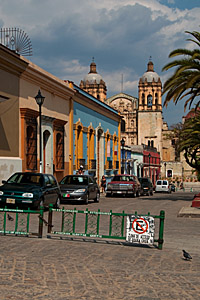
(Oaxaca, Mexico)
Our plane landed in Mexico at 1830. It had been one of the worst winters on record and we had decided to go away for a bit of sun at Easter, the perfect time to visit Southern Mexico. We had been to Mexico eight years previously in the summer when it is very rainy in the South. In addition to the timing we hoped the previous years Swine Flu hysteria and the credit crunch would leave Mexico devoid of tourists. All in all a perfect time to explore the South, temple hopping and diving on the Caribbean coast.
Since we had spent too many days in Mexico City on the previous trip we had decided to ship straight out and had a night bus booked to Oaxaca. Sadly I had left a five hour window between the airport and the bus station. If we had been less tired we undoubtedly would have gone into town as it was Good Friday. As it was we spent the time taking alternate turns to catch up on our sleep. Although it sounds crazy to tackle a six hour bus journey after stepping off a plane the buses in Mexico are quite luxurious. It was quite difficult to sleep whilst hurtling through the mountains however we did manage to catch a few fitful hours. I noticed that I only woke up when the bus braked for toll booths giving me the impression that Mexico was a never ending series of tolls.
We got to Oaxaca at 0530 and magically persuaded our hotel to let us into our room early. We took full advantage of it and grabbed another hours sleep.
Saturday, 3 April 2010
Oaxaca, Mexico
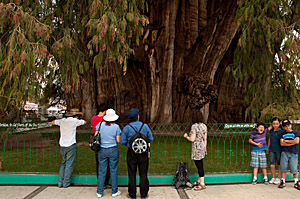
(Tule, Oaxaca, Mexico)
Waking up for the second time in Oaxaca for the second time reminded me why getting away in the winter is always so welcome. Our room in the Casa del Sotano overlooked a courtyard where bird tweeted and on opening the curtains the sky was a perfect blue. Coming from deep winter (two days before a bus had crashed in snow drifts in Scotland) to the equivalent of English summer overnight was like overdosing on good weather. We stumbled out, putting our sunglasses on, and strolled to the town's Zocalo for breakfast.
I opted for Tamales, polenta stuffed with chicken then wrapped in a leaf and steamed. Although the Zocalo was pleasant the number of hawkers started to get annoying. When we finally attracted the attentions of a Mariachi singer we decided it was time to withdraw back to the hotel.
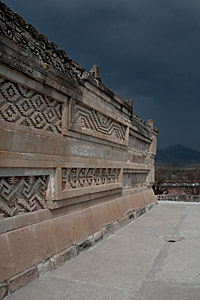
(Mitla, Oaxaca, Mexico)
We had booked to go to Mitla and Hierve el Agua, two of the local attractions. The bus was due to pick us up at 0945. Whilst the bus was on time this proved of little use because we subsequently circled the town trying to find all the other tourists at their hotels. Finally we left the town around 1030 and headed west, I rapidly started to realise why we never book tours, The first stop was in Santa Maria del Tule , a local village with what purported to be the widest tree in the world. It was large and 2000 years old but we stayed there for too long and by the time we were bundled back in the van it was 1100. This is when the fun started. We were placed in a rug weaving factory for a demonstration, then a mescal factory for a tasting and finally an unappealing all you can eat buffet. This last treat Anna and I, and a few other tourists decided to skip. By the time the bus was ready to leave it was 1430, we had been going for four hours and seen nothing.
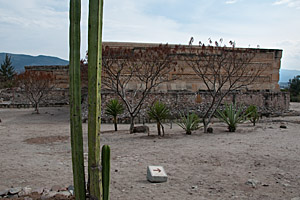
(Mitla, Oaxaca, Mexico)
Finally we got to Mitla around 1500. This turned out to be a bit of a treat as the Zapotec site is not very large but is very intricately decorated with stonework patterns. After this we headed into the mountains to Hierve el Agua , a petrified waterfall that would have been fantastic had it not been Easter weekend and thronged with people.
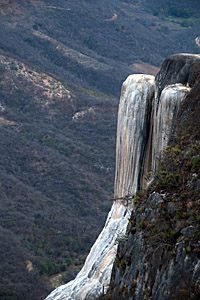
(Mitla, Oaxaca, Mexico)
The setting is stunning, high up in the mountains mineral springs bubble out of the ground and over the lip of a cliff forming a deposits which resemble a waterfall petrified in mid-flow. However a couple of pools places them very firmly on the day trip itinerary and when we arrived coach loads of people were paddling in the pools and generally disturbing the peace. We walked around for the allotted hour only descending to the chaos briefly and then ran back to the van in the vein hope everyone would be as keen as us to get back.
We slept most of the way back and then went straight to a restaurant to see if we could get a table for that night only to find that the only time there would be tables was at the moment. We sat down depressingly dirty from the road and proceeded to have a very mediocre dinner. We had planned to go exploring the city after dinner as it was Saturday night and very lively. However as soon as we got back to the hotel we collapsed into bed, completely worn out from our travels.
Sunday, 4 April 2010
Oaxaca, Mexico
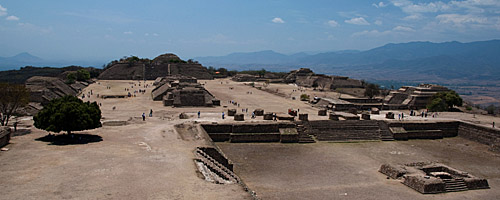
(Oaxaca, Mexico)
To celebrate Easter the locals let off fireworks throughout the whole night and well into the next day. We got up at a very sedate 0900 and had breakfast on the terrace of our hotel which overlooked the rooftops of Oaxaca and had a stunning view of the surrounding mountains which by mid-morning had almost disappeared into a blue haze,
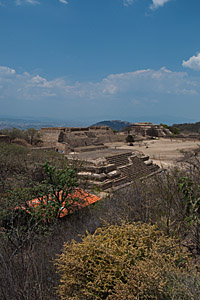
(Oaxaca, Mexico)
We checked out after breakfast and headed to the South of the city to find a shuttle to take us up to Monte Alban . The Zapotec site is about 9km away from and about 400m above Oaxaca. Fortunately there are various companies that run buses up there every thirty minutes so we did not have to wait that long and what not bound by a tour.
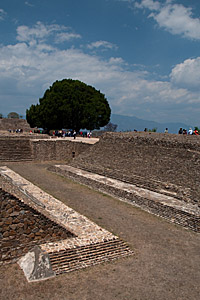
(Monte Alban, Oaxaca, Mexico)
Once in our first views of the Zapotec city were amazing. They had literally levelled off the top of a mountain to build the administrative core of the city. A huge rectangular plaza is bounded at both ends by two steep pyramid complexes. Along the sides of the plaza are various buildings and smaller pyramids. Finally in the centre is an arrow headed observatory, the only building not aligned to a North-South axis.
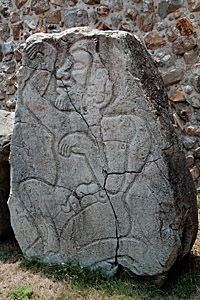
(Monte Alban, Oaxaca, Mexico)
Our first stop was the Juego de Pelota, the I shaped ball court familiar to many pre-hispanic sites. It is generally reckoned that they were used to play a game not dissimilar to racquetball to settle disputes, with the loosing team being beheaded. The court at Monte Alban does not have the hoops seen at other sites, which people have taken to mean it is an early example where the goal was at the centre of the court. We then climbed both of the pyramids to take in the 360 degree views of the surrounding countryside and Oaxaca. The final stop was one of the complexes to see the "Danzantes" a series of naked figures once thought to be dancers but now thought to be sacrificial victims in various poses.
After two hours we headed back down the mountain to Oaxaca. It was about 1500 when we got there so we had about five hours to kill before our night bus to San Cristobal. So we found a nice restaurant with a rooftop terrace behind the Santa Domingo cathedral and had an excellent late lunch. I had chilies stuffed with fried grasshoppers as a starter, with a main of mole a Mexican sauce made with chocolate. We watched the sun slowly descend and after dinner had a few more drinks and wrote diaries.
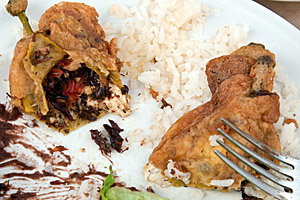
(Oaxaca, Mexico)
The bus to San Cristobal turned out to be an ordeal. The woman across the aisle from us had two young daughters and I was woken at twelve to find one of the retching in the aisle next to me. We were both dumbfounded by the mother's inability top put the child in the bus' toilet and the drivers reluctance to stop and clean up. Fortunately the bus' fearsome air conditioning meant that it was not as bad as it could have been but we were really put off long distance buses.
Monday, 5 April 2010
San Cristobal, Chiapas, Mexico
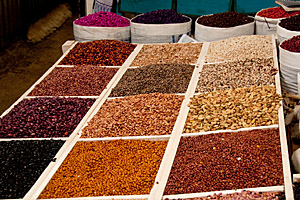
(San Cristobal, Chiapas, Mexico)
We arrived in San Cristobal de las Casas at 0700 and again were very lucky and got straight into our room to take a much needed shower. The hotel was really nice, just five rooms in a colonial house owned by an American couple. It had two inner courtyards full of flowers and the rooms themselves were quite simple but with pieces of heavy wooden furniture.
After our shower we headed out to grab breakfast then walked North to find the local bus station for Chamula. One of the attractions of Chiapas are the highly independent villages which sport a variety of different traditions. In San Juan de Chamula the main draw is the church. We jumped in a local combi and headed off into the hills to see it.
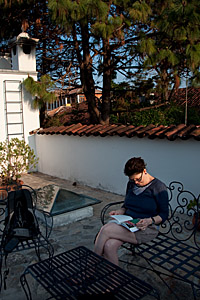
(San Cristobal, Chiapas, Mexico)
The town itself was a bit of a disappointment. There was a huge market but this was overshadowed by the vast numbers of tourists descending on the town. We had to wait until they had somewhat dissipated before going in. Inside the floor was covered by pine needles which various villages had made clearings in and arranged groups of candles. The church has no priests or services and the villagers follow a mixture of Christian and indigenous beliefs. These candles formed their own shrines over which they kept vigils, some of them chanting continuously. I felt even though we had paid an entrance fee we were very much intruding so left quickly.
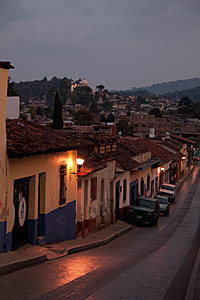
(San Cristobal, Chiapas, Mexico)
Outside we found some postcards of Subcomandante Marcos leader of the Zapatista liberation army which in 1994 seized San Cristobal and a number of other towns in protest at the huge divide between the rich and poor indigenous people in Mexico. Although the towns were quickly recaptured a low level guerilla war was waged and did not end until 2001. Marcos himself is obviously a very recognisable figure with his trademark balaclava and pipe, however I worry that, not by his own intentions, his own fame somewhat overshadowed what the protest was actually about.
After Chamula we went back to San Cristobal. We had a brief walk around the streets then retired to our hotel for a well earned siesta. Our heads hit the pillows at 1500 and we did not wake up until three hours later. That night we had dinner in a very nice restaurant then stayed up to midnight listening to live music in a bar just off the main square. For 2500m above sea level we had a bit too much to drink but clearly San Cristobal is a tourist town so partying seemed very much the thing to do.
Tuesday, 6 April 2010
San Cristobal, Chiapas, Mexico
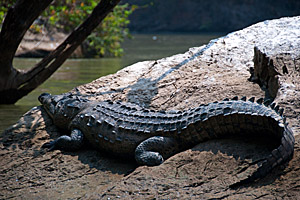
(Sumidero Gorge, Chiapas, Mexico)
We had arranged another trip, this time to the Sumidero Gorge , a not so natural phenomena 60km west of San Cristobal. We were bundled into a minibus at eight and spent two hours getting there then piled into a motor boat to ride 40km up and down the gorge.
The gorge was very dramatic however with thirty boats ploughing up and down it was far from serene. Whilst we saw quite a bit of wildlife, notably crocodiles, you could not help feeling that the only wildlife which stayed was that which could stand the continual disruption. It got worse, when we got to the lake at the top of the gorge, created by a hydro electric dam, two helicopters zoomed out of the gorge. With this and the jungle the whole scene was more reminiscent of Apocalypse now than a visit to a nature reserve.
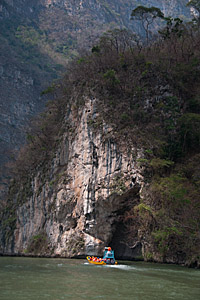
(Sumidero Gorge, Chiapas, Mexico)
After four hours in the gorge everyone was a bit heat struck so we were all a bit shocked to be dumped in the town centre of Chiapa de Corzo . in the centre of the zocalo was a large brick fountain of a very ornate construction. However after about five minutes of looking at that the heat set in and everyone struggled to fill in the entire hour. Everyone except one person, a long haired American traveller who got back to the bus fifteen minutes after the allotted time. This in itself created an interesting episode in group psychology.
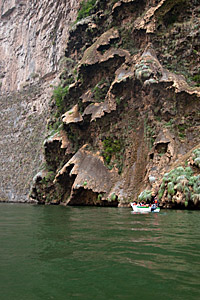
(Sumidero Gorge, Chiapas, Mexico)
The bus driver was a bit perplexed as to what to do so decided to put it to the vote. "Vamos?" was the question to which everyone except a couple of people replied "si". Although it sounds bad we were only a twenty pound taxi ride away from San Cristobal and at 30 degrees even in the bus everyone was pretty annoyed he could not be bothered to arrive on time. Anyway in the end it did not come to it as the guy turned up as if nothing had happened. This in turn started another disturbance as some Russians started insisting that he give us a verbal apology.
When we got back we again employed the siesta to recharge our batteries before heading out for dinner. However there was not much partying to be done that night as we were due to get up at 0530 the next morning for our trip to Palenque.
Wednesday, 7 April 2010
Palenque, Chiapas, Mexico
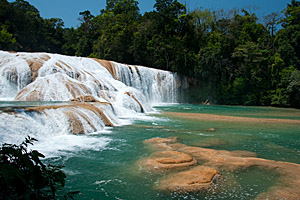
(Palenque, Chiapas, Mexico)
It was a very early start. We had some breakfast at 0600 and a minibus arrived for us at 0630. We piled in then everyone promptly fell asleep as our next destination, a waterfall on the route to Palenque, was over three hours away. We stopped for breakfast at a fairly clean pit stop at around 0800, although we had already had some so did not partake. We then got to Agua Azul around eleven. The bottom of the falls was a bit of a nightmare with hundreds of vending stalls catering for an equal number of tourists. However after walking just twenty minutes beyond the main falls the crowds started to thin out. In fact beyond it was a really idyllic location with a completely blue river which worked its way over a series of falls. Further upstream there were families having picnics and swimming in the water and just generally chilling out.
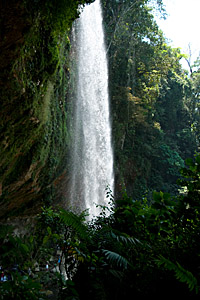
(Palenque, Chiapas, Mexico)
We probably enjoyed it a bit too much and came back exactly on time to find everyone waiting for us and the bus driver starting to panic. We quickly jumped in, fearing the same backlash as experienced by the American the day before, and headed off for the next waterfall. Misol Ha is possibly the archetype of all waterfalls, a circular pool in the middle of the jungle with water cascading into it from an overhanging rock 50m above. It even came equipped with a hedge which allowed people to walk behind the cascade whilst getting slightly damp. This time we made sure we were not the last back to the bus.
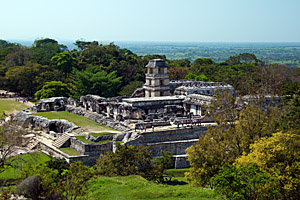
(Palenque, Chiapas, Mexico)
I had built Palenque up to be one of the highlights of the trip, I had seen photos of it years ago and with its jungle location and intricate temple designs it had made a big impact on me. In the end it did not disappoint, the pure white limestone contrasted with the green of the jungle and the grass lawns between the buildings.
It was a sizzling hot 35 degrees so we had to choose our route carefully. Thinking that we would run out of energy quite quickly we first ascended to the top of the Templo de la Cruz for the money shot, a view over the main Palacio with the jungle surrounding it. Then we descended to see the Juego de Pelota, a very subtle affair compared to Monte Alban with no built up sides. After that we explored another group of temples and finally braved the Palacio which, with its searing white walls, proved to be as much as an oven as it looked.
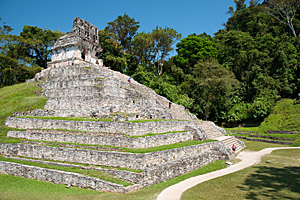
(Palenque, Chiapas, Mexico)
The Mayans ruled Yucatan in two distinct periods. The Classic period was from 250 to 800 AD and during this time they ruled from sites in the South of the Yucatan including Palenque, Tikal and Calakmul. The civilisation then collapsed, perhaps to 10% of its population, only to re-emerge 200 years later and rebuild itself around new centres further North in Uxmal, Chichen Itza and Coba. The collapse is hotly debated but in Node: link Jarred Diamond focuses on drought being the leading cause. The karst landscape of the Yucatan means that no rain gathers on its surface. The southern regions, lacking the cenotes of the North quickly descended into anarchy as a result of a series of droughts over the period of a hundred years. In addition their growing populations had meant that they increasingly deforested the slopes of the hills leading to mud slides etc. Both factors meant the Southern cities were either abandoned or their populations slowly killed off.
Following the site we were dropped at a bus station in Palenque town. We had about five hours to kill before our night bus to Merida so went to a restaurant and hung out there for a few hours then went back to the bus station.
Thursday, 8 April 2010
Merida, Yucatan, Mexico
Our hotel in Merida was an odd experience to say the least. We arrived straight off the bus and as always asked of the room was free to check into. Rather than saying no or having a look the ex-pat running the hotel looked at us in a mystified manner as if we had asked something totally unreasonable. He advised us to have breakfast whilst he looked into it. Fortunately whilst our room was not ready he eventually found a free room, which we just had a shower in, then set off to have a look around town.
As we had been travelling for over twenty hours we had purposefully left this as a free day. We went to explore the city's sites starting with the museum of contemporary arts. This turned out to be a bit of a let down as most of the galleries were closed for refurbishment. So after looking at some murals in the Governor's palace we decided to have an early lunch and found an excellent place for some octopus cerviche.
After this we went to pick up our hire car. The Yucatan is a relatively easy place to drive and our final destination of the holiday was very remote requiring us to have our own transport. Once we had the car we decided that Merida, having a large American ex-pat community, the place to while away the afternoon would be the shopping mall to the North of the city. This turned out to be a good call as outside it was a blistering hot forty degrees. The mall itself was completely western with many American and Spanish chains but it killed a couple of hours, after which we went back to the hotel for a siesta.
The evening was considerably cooler benefiting from a sea breeze. We had dinner in a fairly slick Mexican eatery and then went for a tour round the streets. It was a very lively place by night with concerts arranged most nights in each of the centre's main squares. With the breeze and the activity Merida was certainly a lot more attractive at night.
Friday, 9 April 2010
Merida, Yucatan, Mexico
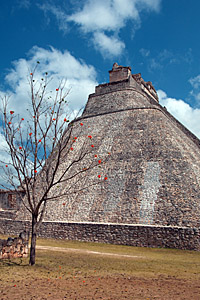
(Uxmal, Yucatan, Mexico)
We got up relatively early to tackle the drive to Uxmal and the Ruta Puuc, a chain of Mayan sites south of Uxmal. The drive out was pretty uneventful. The jungle in Yucatan is very seasonal and in the dry winter months becomes and endless flat scrub, very dry and with very washed out colours. It took us about an hour and a half to reach the site by which time it was 0900.
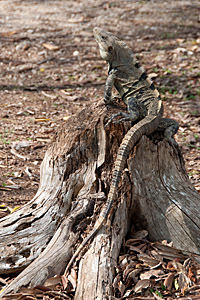
(Uxmal, Yucatan, Mexico)
It must be said that whilst not the most impressive of Mayan sites Uxmal was definitely the most pleasant site we visited in Mexico and would be up there on our top ten list globally. The first plus point was that early in the morning there was hardly anyone there. There were no buses only a couple of private cars like us so it was very quiet. Secondly it is set out in the scrub so there is plenty of wildlife going about its business. Huge iguanas strolled around and a variety of colourful birds chattered throughout the morning making it very tranquil.
We could not climb the amazingly steep Pyramid of the Magician so went round it to explore the Nunnery. From their we went South to a pyramid from which we got an amazing view out over the whole complex. You could see scrub stretching out for miles around so it was clear to see how the pyramids of Uxmal would have impressed anyone approaching. Very little is known about Uxmal other than that its rulers led the region in an alliance with Chichen Itza from around 900 to 1200. The architecture was certainly very different to that at Palenque and the buildings were amazingly well preserved.
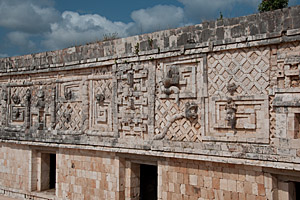
(Uxmal, Yucatan, Mexico)
After Uxmal we went to Kabah which is about 10km down the road. Whilst not as extensive the site was again incredibly quiet and featured the somewhat insane Coodz Poop a building literally covered in stone faces of the rain god Chaac. This was somewhat unsurprising as the area has no cenotes to supply it with water thus the locals were very reliant on gathering water using artificial cisterns.
We missed out on a couple as we felt we did not want to burn ourselves out with endless ruins, so we finished up with Sayil , an earlier city inhabited during the end of the classic period. The site is clearly less grandiose than others which has led to the suggestion that it was a less centralised community with several families ruling it rather than just one King.
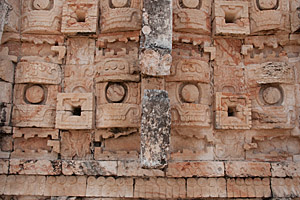
(Kabah, Yucatan, Mexico)
It being lunch time and us being thoroughly bored of dry plains we decided it was time for us to head for the ocean. We turned the car around and drove all the way back to Merida and beyond on to Progresso on the Caribbean coast. From there we headed East to Chicxulub, a small fishing village where we found an excellent seafood restaurant, Los Barilles, which caters for the mainly local holiday makers. It was a nice change from the endless tortillas and variants and it was good quality. It was so good that when we made it back to Merida, after an unsuccessful detour to try and see flamingoes, we only had room for an ice cream before going to bed.
Saturday, 10 April 2010
Valladolid, Yucatan, Mexico
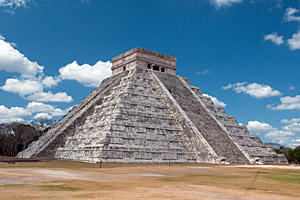
(Chichen Itza, Yucatan, Mexico)
Following on from our very positive experience at Uxmal we decided that getting to Chichen Itza as early as possible was the way to go. We woke up just after 0600 and slipped out of the hotel around 0700. We then had a bit of an upset with our hire car. We were on our second car. Out first a Clio had exhibited extreme steering problems so we had swapped it for a very plastic Chevy the evening before. However when we got in it that morning it would not start. Convinced that it was a flat battery we called the hire car company who were very unawake and looked like they were going to take hours to turn up. Fortunately however rather than waiting forever Anna managed to figure out that it was a safety feature of the car. The clutch had to be depressed for the car to start. Talking to American's later this seemed to be fairly common feature for American manual cars as automatics are more prevalent.
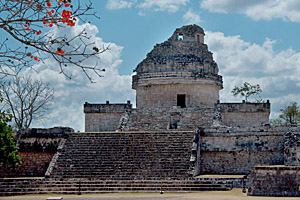
(Chichen Itza, Yucatan, Mexico)
We finally got to Chichen Itza around 0930 and there was thankfully still only one tour bus. Its hard to explain the impact of walking in the entrance and approaching El Castillo, the iconic pyramid. Its so well proportioned and the restoration work so good that it really gives you a great idea of how other worldly and impressive the whole complex must have seemed to the ordinary Mayan people.
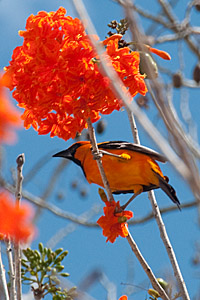
(Chichen Itza, Yucatan, Mexico)
Also impressive is the huge Juego de Pelota. With its target hoops some 9m above the ground its very difficult to see how they were part of the ball game. There were some murals in the court which depict the game however its difficult to discern any of the rules and it seems possible that the hoops were really just for some form of decoration or possibly just to hang a net.
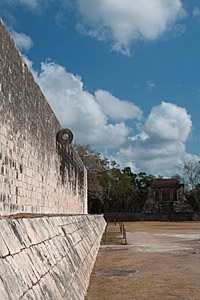
(Chichen Itza, Yucatan, Mexico)
Chichen Itza's other iconic building is El Caracol an observatory so named because of its snail like dome. Whilst many sites in the Americas have a building tagged the observatory in the case of El Caracol its very easy to see the resemblance to modern day observatories. However as always this is all theory based on the fact that various windows align with various stars and planets at various times of the year. One annoyance however was that it was totally roped off so that you could not get a decent photograph of it in the morning.
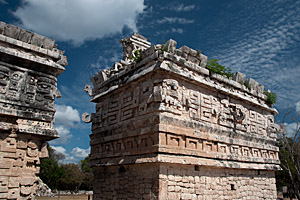
(Chichen Itza, Yucatan, Mexico)
We also visited the scared North cenote (more of which later) which although a bit murky clearly could serve as a water source for the town. We then drove up the road to Valladolid where we were to stay the night. The third biggest city in the Yucatan the town was the scene of a Mayan uprising in 1847. We checked into our hotel, had some lunch and then headed out to visit a cenote.
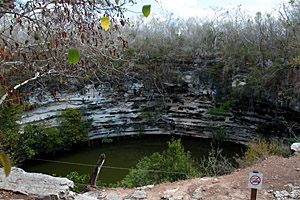
(Chichen Itza, Yucatan, Mexico)
Owing to the karst landscape the Yucatan peninsula has no rivers so fresh water gathers in underground sinkholes called cenotes. As well as being the source of water for the Maya, in several place these cenotes are accessible and used as public swimming baths. We drove to one just outside Valladolid where a small tree had caused a partial collapse of the roof. The roots of the tree reached 30m down to the pool and the whole it had opened up let in intense shaft of light which lit up a section of the almost crystal clear water. We changed into our trunks and went for a paddle in the pool whilst worryingly large black fish swam around looking at us. After our swim we returned to the hotel and chilled out by its pool until afternoon when we had a very nice dinner.
Sunday, 11 April 2010
Xcalak, Quintana Roo, Mexico
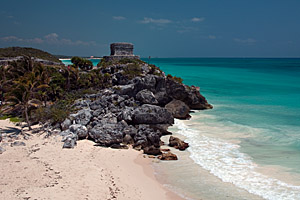
(Tulum, Quintana Roo, Mexico)
We had divided our holiday into two parts. A whirlwind temple hopping tour of South Mexico followed by a week's diving and sunbathing by the Caribbean. We had chosen the most remote place we could find, Xcalak, almost 300km south of the madness of Cancun and only just North of the border with Belize. It took us most of the day to drive there with a brief stop at Tulum a very photogenic temple on the top of a small cliff overlooking the turquoise blue waters of the Caribbean. Sadly we were not the only people to find it photogenic, the whole place was crawling with day trippers from the endless string of resorts from Playa del Carmen to Cancun.
To get out to Xcalak we had to drive 100km down a peninsula. The terrain was one of salty marshlands, mangroves and scrub. However when we got there we found that the journey was more than worth it. Our "hotel" was a collection of bungalows on 100m of private white sand beach. It had everything you needed for a perfect getaway, white sands, coconut palms, a dock reaching out in to the sea and a chiller full of ice cold beers which you helped yourself to. Better than this there were never more than four couples there our entire stay and at one point it was only us, another couple and Don and Cindy the owners who looked after us all in an amazing way.
Once we had dropped our stuff we immediately went for a swim and some sunbathing. Then later on that night Cindy cooked everyone dinner, after which we stayed up talking to the other guests collapsing into bed around 2200.
Monday, 12 April 2010
Xcalak, Quintana Roo, Mexico
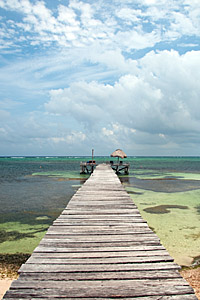
(Xcalak, Quintana Roo, Mexico)
I did not keep a diary for the next five days as we fell into a routine. Every morning we would wake up, have breakfast then drive down to the dive shop in town. We would then do a couple of local dives in the beautiful marine park reef just off shore. The reefs were in good condition with a large variety of fish and other animals. After this we would go back to the hotel for a light lunch, then sunbathe the whole afternoon until we had to get ready for dinner.
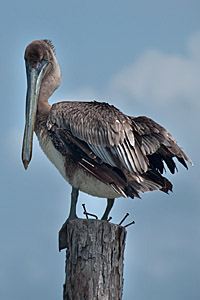
(Xcalak, Quintana Roo, Mexico)
Very little broke our routine. On Wednesday Don and Cindy took us to a local barbeque. As it was such a small ex-pat community, we knew most of the people but we got to meet a few more of the locals, including an ex rocket engineer. Another night we went to a local restaurant which was run by two Canadian ladies who served the most spectacular food but was only open a couple of nights a week.
All in all it was a very relaxing five days. Xcalak is a very sleepy place surrounded by a National Park which will slow further development for years to come. It was absolutely the place to recharge our batteries after the first week of our holiday.
Saturday, 17 April 2010
Mexico, District Federal, Mexico
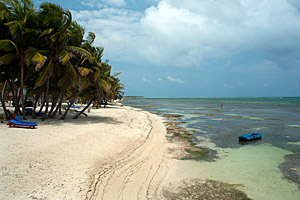
(Xcalak, Quintana Roo, Mexico)
Almost completely cut off from the outside world in Xcalak with no mobile reception, television or Internet Don had told us a bit of news. A volcano had erupted on the Wednesday and the Ash cloud had put a halt to all flights in Europe. It seemed a bit unlikely so we set off at 0630 on our journey back perhaps a little unprepared for what we would find.
We drove non-stop to Puerto Morales where we stopped for a spot of lunch. From there it was only another twenty minutes to Cancun airport where we turned in a very dirty hire car. We had a brief argument with the hire company who tried to pin responsibility for a scratch on the car on us but I managed to browbeat them into accepting it was already there when we hired it. We then got on a plane for Mexico City to see what we would find.
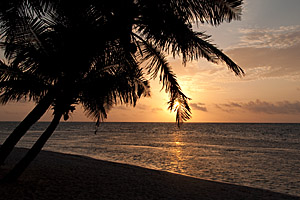
(Xcalak, Quintana Roo, Mexico)
The answer was not good. A very uninformative girl at the BA check-in desk told us that she did not know what was going on and that she could not see us lying anywhere this week. She was so unhelpful that it was only through very pointed questions that we found out that BA were arranging for everyone to stay at hotels and that we should go to the Holiday Inn and we would get more information via their web site. It was very badly handled. Although they were as much at the mercy of the volcano as us this had been going on for a couple of days when we arrived and they could at least have put together what information they did know into a handout and outlined a couple of options for getting us home when the ash finally cleared.
When we got to the hotel we found it only had a couple of computers which were permanently in use by fellow passengers so we decided to head into the centre of town for some dinner at a restaurant we had dined at when we were last there eight years previously.
Sunday, 18 April 2010
Mexico, District Federal, Mexico
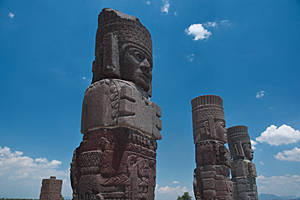
(Tula, District Federal, Mexico)
We had realised we were not going anywhere for a few days so decided to make to most of it and do some sight seeing. We had already been to a lot of the sites in the city so decided to head for Tula , the capital of the Toltecs. The Toltec civilisation pre-dated the Aztec and there is some debate about how wide spread it was. Some scholars assert that it is just a generic term used to cover several city states, of which Tula was one, from which the Aztecs emerged.
Getting to Tula is quite a lengthy process. Getting to the town itself is an hour long bus journey from the Northern bus terminal. Then its about a thirty minute walk from the bus station to the site. This itself was very peaceful, you first walk through a field planted with different varieties of Cactus and then you find yourself at the foot of the main pyramid. On top of the main pyramid are four huge columns carved in the shape of Toltec warriors. These Atalantes were thought to support the roof of the entrance to a temple on top of the pyramid. It was very difficult getting a photo of them without a Mexican clinging to one of them.
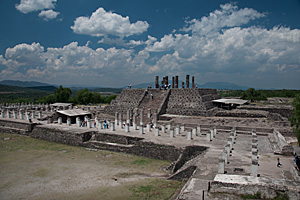
(Tula, District Federal, Mexico)
The other unusual feature of the site was that there appeared to be some sort of pagan festival going on. Fifty or so people clad in white robes chanted in the central square of the site whilst doing some sort of Tai Chi. We stayed for a while relaxing atop the pyramid but never worked out what they were doing. After an hour at the site we walked back into town and then jumped on a bus for Mexico City.
BA had told us they would brief us that afternoon at 1700 on the latest news so we rushed back to the hotel. However despite getting there on time we were told they had been and gone two hours before, very annoying. That night we made the big mistake of having the free buffet in the hotel. Clearly the hotel knew they were only going to get minimal return from accommodating hundreds of stuck tourists on the airlines behalf so had devised a scheme to make it as cheap as possible for themselves.
Monday, 19 April 2010
Mexico, District Federal, Mexico
We had got bored of waiting so had decided to do some asking around. First stop was the British Embassy in the Zona Rosa. Here they were sympathetic but not able to do a lot, advising us to just stay put until BA started flying again. On this front it looked like we had no choice, although we could reach the US BA had no way of getting us on onwards flights as they were all booked solidly for the next three weeks. We did however discover whilst there that we were comparatively lucky. We ran into some other Brits who had flown out with AeroMexico. The airline was under no duty too put them up so they had to pay for the extra days they were stuck there.
We spent the afternoon in the very posh suburb of Polanco shopping and had dinner there at a very nice Spanish restaurant. After dinner we stumbled back into the hotel at eleven only to find a message waiting on our answering machine. We were to get to the airport for 0100 and we were going to fly back at 0300!! It was a very interesting situation, the BA plane from Mexico to London had to turn around because of the Volcano on Wednesday night so the crew had been stuck there for five days and were keen to go. Meanwhile Willie Walsh had been arguing with the Civil Aviation Authority in the UK that it was safe to fly and had been on several test flights himself. That Monday he had taken matters into his own hands and ordered 24 planes at long haul destinations all to fly back, gambling that the Prime Minister would let them land.
We had to pack in a matter of minutes as we knew there were only a finite number of seats on the plane. We then dashed to the airport and queued up, the staff again were not terribly reassuring, making us read notices to the effect that we knew we might not land in the UK and may be diverted to a different location. We waited for at least an hour on the tarmac and finally took off not knowing what would happen.
Tuesday, 20 April 2010
Shannon, Clare, Ireland
We flew for most of the day predictably not seeing any volcanic ash clouds. Around 1900 we were above lands end asking for permission to enter British airspace. We knew it was not good when the plane started circling and then finally peeled off in the direction of Ireland. As it turned out had we been an hour later we would have been allowed to land. We touched down in Shannon were there were five other transatlantic planes. For a while it looked like we would get back to the UK that night as the airspace had been re-opened. However in the end the crew had gone over the hours they were allowed to work and so we were bundled out to stay in a rambling hotel in the countryside nearby.
Wednesday, 21 April 2010
London, United Kingdom
The next day Anna decided she had enough and that we were going to go back overland. So we got up before everyone else, grabbed a cab to Limerick and then found a bus to Dublin. From there we were very fortunate to get on standby for the lunchtime ferry to Hollyhead. We got there around 1700 and then boarded what must be the slowest train in the world back to the west coast mainline and finally from there back to London. We stumbled in the door around eleven, three days late but just thankful to be back!!





